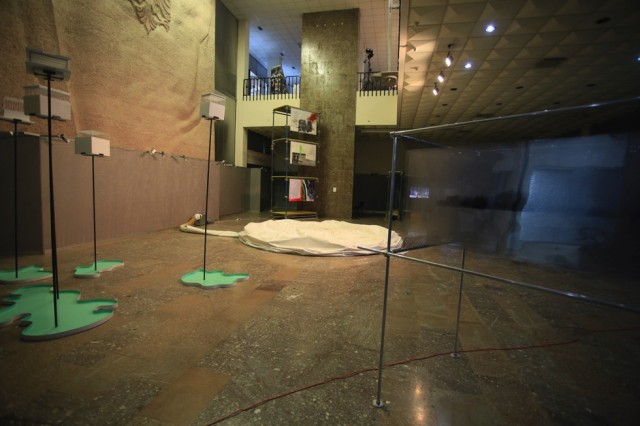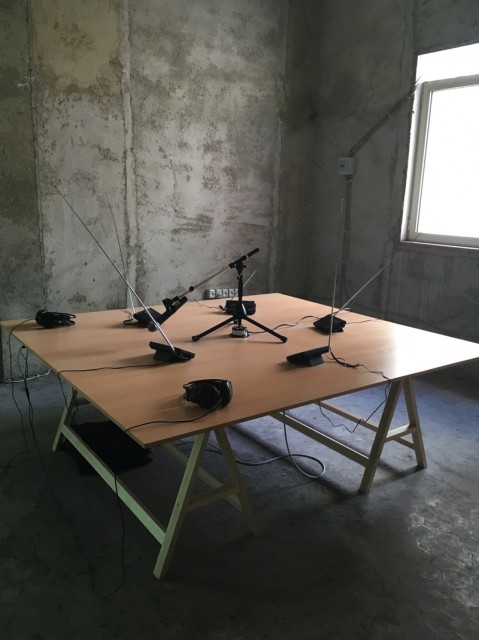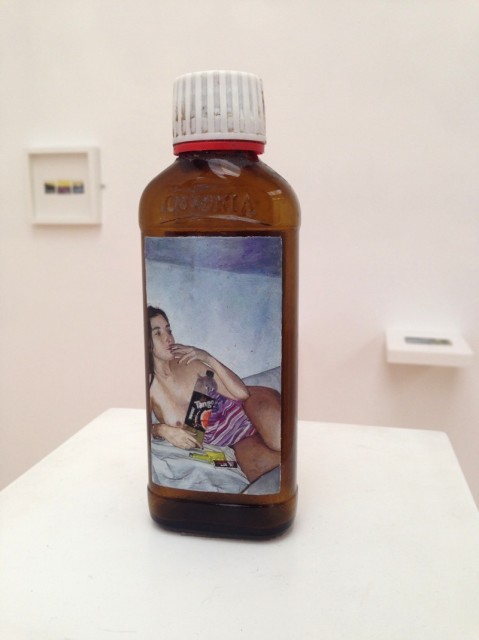Field Trip: Mediterranea 18 (Young Artists Biennale), Albania

Niki Russell boards a ferry in order to reach the Young Artists Biennale in Albania, and finds that the festival’s larger themes — of history, conflict, dreams and failure — stimulate dialogue between different cultures…
Mediterranea 18 was the latest iteration of the Young Artists Biennale, a nomadic multi-disciplinary format that brought together hundreds of artists with the intention of promoting dialogue and collaboration. This itinerant gathering is organised by BJCEM (Biennale des Jeunes Créateurs de l’Europe et de la Méditerranée) – a loose network made up of 59 members from countries across Europe – and encompasses a dizzying array of cultural production including cinema, music, food, art, theatre, dance and literature.
The 18th edition of the Biennale was held for the first time in Albania, between the capital Tirana and the port city of Durrës (4-9 May, 2017). However, for artists, press and partners the event actually began with a somewhat perplexing detour via Bari – in the Puglia region of Italy – for a pre-Biennale event. Arriving part way through the press conference might have placed me at a disadvantage, but judging by other bemused faces around the room I was not the only one still seeking elucidation on the exact matter in hand. Why were we here, in this theatre – in the industrial hinterland of Bari? A large group of curators, partners, artists and politicians, took it in turns to voice approbatory remarks – both in relation to this particular Biennale and its history more broadly. The group were seated on Michelangelo Pistoletto and Juan Sandoval’s furniture-cum-installation Mar Mediterraneo – Sedie Love Difference; comprising sixty chairs that together form the shape of the Mediterranean, and intended to create a speculative arena to stimulate dialogue between different cultures.
As the conversation reached the Biennale’s theme History + Conflict + Dream + Failure = HOME, one historical point of reference for beginning our journey in Puglia, is that of the Tragedy of Otranto – where in 1997 the boat Katër i Radës, carrying refugees fleeing Albania, capsized in a collision with an Italian vessel, resulting in the death of many of those aboard. This moment in history draws attention to the bonds that connect the people of Puglia and Albania, by remembering this tragic incident, but also posits new relationships that are necessary for reconsidering Europe and the Mediterranean today. This journey was re-presented physically, as we left Puglia that same evening aboard the overnight ferry from Bari to Durrës. A performative discussion promised to probe and elaborate on the themes of the Biennale, but frustratingly quickly fell back on ground covered in the earlier press conference. I therefore chose to leave the discussion behind to explore the other accessible spaces on the ferry. In doing so, it was difficult not to see a missed opportunity to use this journey as a further site for the Biennale. Nestled at the rear of the ferry on the upper deck, regular passengers – largely native Albanians – picnicked and socialised around fixed tables. This convivial public space is separated from the private Mediterranea 18 event below, but gradually the two overlapped as more Biennale passengers emerged out onto deck to continue conversations and drink late into the night.

The next morning after a coach ride from Durrës we arrived in Tirana for the inaugural event, with the official programme of 230 selected artists offering an extensive daily programme of music, film, performance and literary offerings across the two cities. One-off, live events interspersed my journey to reach the visual arts programme, which was sited in five main venues – at the National Historical Museum (pictured, above), National Gallery of Arts, Former Embassy of Yugoslavia, Youth Centre and the House of Leaves. With the latter two of these venues quite slight, the majority of the work was housed within the remaining triumvirate, with the most engaging of these being the Former Embassy of Yugoslavia. This empty shell of a building, with bare walls and concrete floors, broken windowpanes and upturned grand piano, was refilled with objects of domesticity and layered with other spaces transferred onto this architecture.
Andre Fama’s cement sculptures lean casually against the walls, and resemble casts of another place, architectural support structures relocated from one space to another. In Margarethe Drexel’s video her body performs the rooms that make up an unknown house; these strange acts seek to defamiliarise the space, and the objects contained within, challenging the social conventions of the home. Further extraction and layering of external landscapes can be seen in Lidija Delic’s Sunset Journeys, where small landscape paintings merge with the columns and rows of account ledger paper. On top of these sunsets, stripes of correction fluid serve both to blank out textual description and to create a void to later be filled. Theodoulos Polyviou’s Radiator and Supporting Grab Rail play with the materiality of domestic space, inserting anomaly and convolution into otherwise familiar architectural furniture – as the functionality of a safety device receives an aestheticised flourish, and the pipes of a radiator contort into knots. Austrian group Jurgen Kleft ask us to think again about the meaning of shelter, through a more temporary form of housing – that of distorted camping equipment. Gathered around the old fireplace at the former embassy sit a collection of sculptural objects, some proffer semi-functionality as a jacket, rucksack or tent, whilst others such as Obelisk Laterne start to take on ceremonial purpose. Together these objects appear to function as set and prop for some performance yet to come.

Video and sound feature strongly across the visual arts at the Biennale, exemplified in works by Faxen (pictured, above) and Siniša Radulović, which are located in adjoining rooms at the Former Embassy of Yugoslavia. In Austrian collective Faxen’s Transposition a slowly rotating microphone moves in and out of range of portable radios each tuned into a different frequency, picking up broken snippets of spoken language, the faint trace of musical fragments and the crackle of static. This sonic experiment with everyday domestic equipment presents an evolving soundscape as it fades in and out, and begins to blend the language and tone of different stations from around the world – subtlely referencing the emigrant countries of the Albanian diaspora. Siniša Radulović’s video Indivisible and Inseparable presents a continually shifting collage of video clippings. This desktop of overlapping source material is accompanied by a spoken monologue combining generic political speeches and national mythologies with trivia and misuse of statistics: “10,763 birds die each year smashing into windows”. With its lack of linear narrative the work speculates on the future of former Eastern Bloc countries – such as the Radulović’s native Montenegro – where the promise of progress, of a transition to a market economy is filled with empty rhetoric, and where the dominant voice becomes a mantra, like the endless hum of a self-improvement tape.
Participation in Mediterranea 18 is in part determined by nationality, with artists selected and brought to the Biennale by national partner organisations that make up BJCEM. Whilst this does not necessitate that artists from a particular country are shown together – there are certain groupings that emerge, such as on the ground floor of the Former Embassy of Yugoslavia where there is a strong representation from both Austria and Montenegro. The majority of partners are from countries bordering the Mediterranean Sea – as the name of both the Biennale and the lead organisation would suggest – but there are also partners from countries further afield, such as UK Young Artists. The UK contingent at this edition were visual artists Ant Hamlyn and Conor Rogers (pictured, below), alongside Maryam Tafakory, Toby Campion, Jamal Sterrett and Sadegh Aleahmad, featuring respectively in the film, literary and performance sections of the programme. Displayed at the National Gallery of Arts, Conor Rogers’ intricate paintings depict scenes of people’s everyday lives applied to banal objects – such as the surface of a scouring pad, the label of a medicine bottle or the exterior of small plastic “baggies”. Ant Hamlyn’s inflatable structure is installed at the National Historical Museum, where the The Boost Project encourages audiences to follow/like/tag via social media in order to contribute to its growth – resulting in a form that can be swollen like a ripe pumpkin, or as likely to be crumpled in a heap through inattention.

Further video works that stood out at the National Historical Museum were Vangjush Vellahu’s Fragments and Nicolas Vamvouklis’ And It Feels Like Home II. Vellahu’s multi-channel video installation is part of an ongoing series that document the existence of unrecognised states – in this instance shot in Abkhazia, Varosha and Agdam. These videos feature interviews with people who live in these states, whilst visually dwelling on the particular architecture in each location. As the camera pans across abandoned buildings we are urged to consider the memories that are embedded in each of them, as well as being confronted with the state of limbo or frozen conflict that exists in each place. In contrast, Vamvouklis’ short video loop is a fixed shot of a building on a lake at Berlin Zoo. Seen through the large window, it focuses on the life of a group of flamingos contained inside – who have been relocated in response to the outbreak of H5N8 flu in Germany (sometimes called bird flue virus). This strangely unsettling scene reflects in a different way on issues of dominance, control and freedom of movement.
As a showcase for artists working across Europe at this moment in time, the event succeeded in making visible artists’ practices not currently well-known outside of their home countries. However, the experience of attending left questions about the function of the Biennale – what does it do for the artists involved? And for the city that hosts it? The venues for the Biennale are either in non-art spaces, disused buildings, or in-between spaces at Galleries and Museums. Sometimes this adds a further dimension to the installation, as with the Former Embassy of Yugoslavia, but at other times the siting of work felt awkward or ill-considered. Despite being widely marketed across the city the event struggled to connect with a wider audience beyond those directly connected to the Biennale. In one sense, this highlights the lack of visual arts infrastructure in Albania, with few galleries or institutions focused on contemporary art. There are few non-profit art spaces in the city, one of the few I visited whilst there was Tirana Art Lab – an independent space offering a diverse programme of exhibitions, residencies and research activity. In conversation, it became clear that they felt a lack of criticality in the city, an issue that they had a desire to change by connecting Albanian artists with those in the immediate Balkan region as well as further afield across Europe.
In this context, what role could, or should, the Biennale have taken in contributing to the development of a critical infrastructure in the city? Albanian artists were strongly represented, in number, within the programme, and therefore for those participating the Biennale it offered a concrete opportunity to connect with peers across Europe. Having initially been “conceived as a multi-disciplinary meeting”, the Biennale clearly still performs this function, and many of the artists involved expressed excitement in the opportunity to connect not just internationally but also across disciplines – and for them the experience was about much more than simply the presentation of work. It therefore feels important that the Biennale is able to more fully communicate this aspect of what the event does – the intangible benefits to those involved.
Niki Russell
Niki saw Mediterranea 18 between 4–9 May 2017 in Tirana and Durrës, Albania
For more information, see Mediterranea 18 and BJCEM (Biennale des Jeunes Créateurs de l’Europe et de la Méditerranée)
All images courtesy of artists and BJCEM





